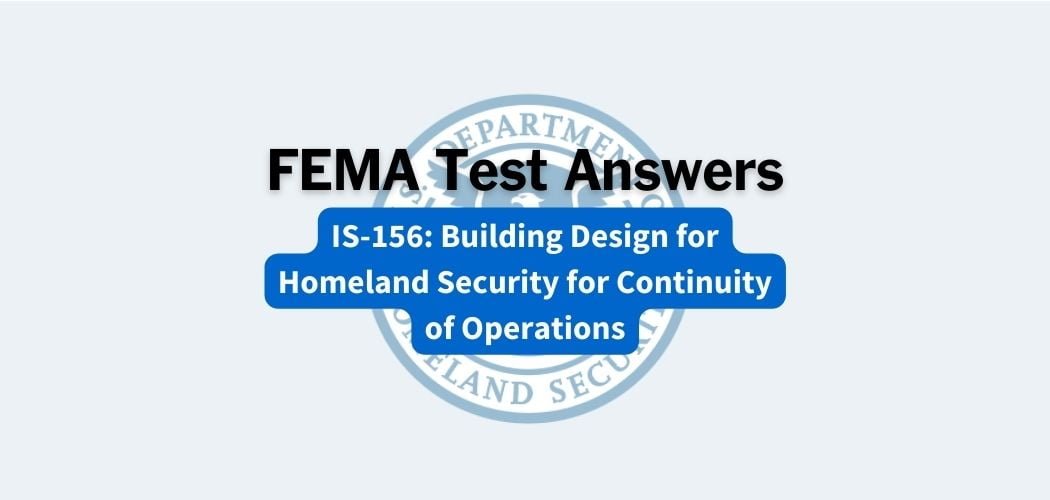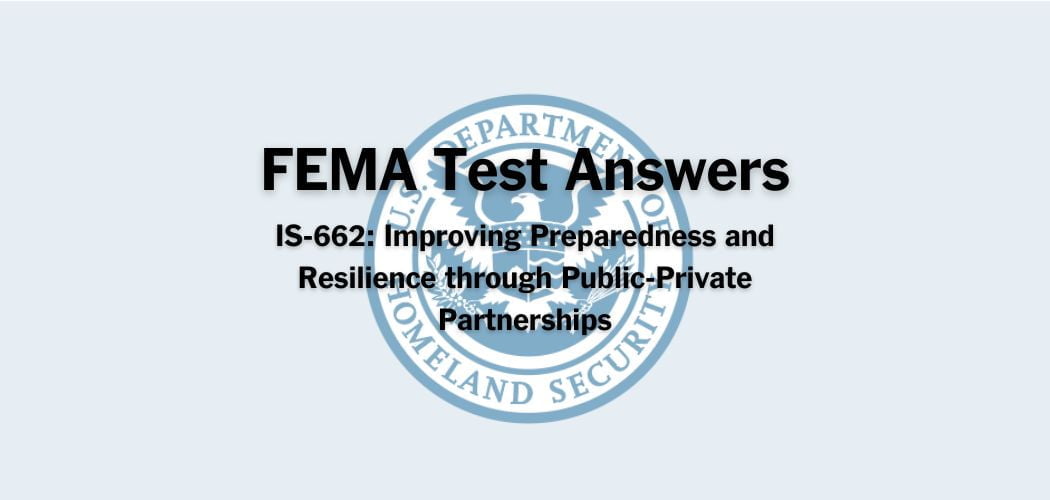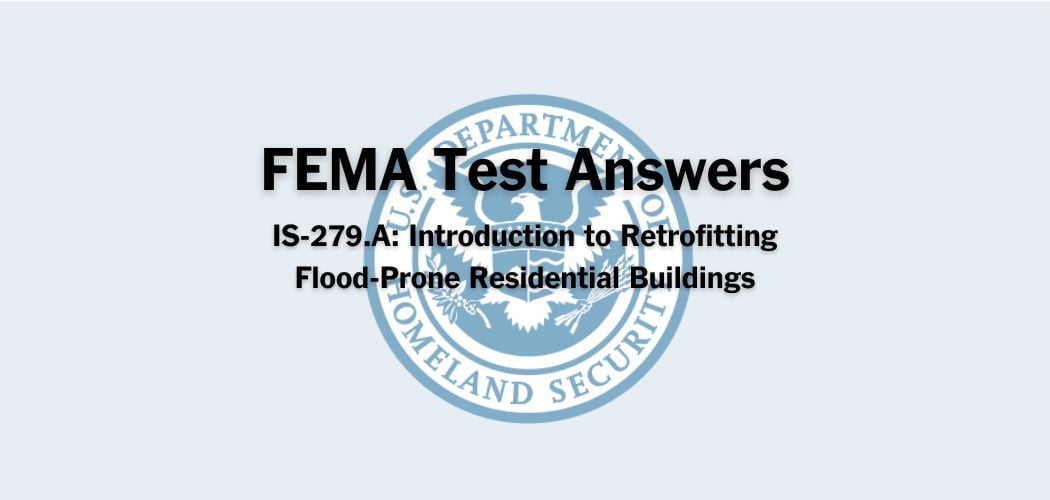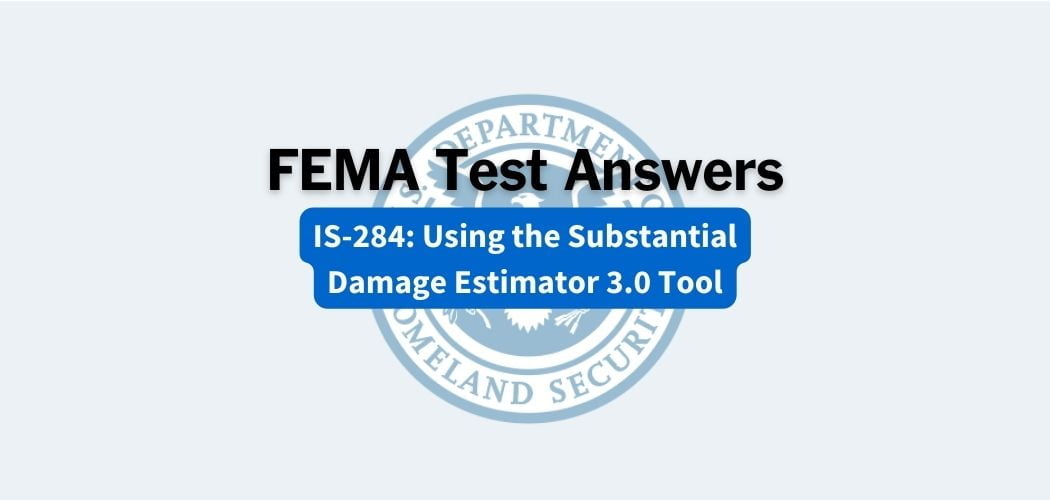Overview: The FEMA IS-1014 course was published on 2/28/2019 to provide an overview of how to integrate Section 406 Hazard Mitigation into the Public Assistance grant application.
By the end of this IS-1014 course, State, Local, Tribal, and Territorial Applicants and Recipients will be able to understand all aspects of Section 406 Hazard Mitigation of the Robert T. Stafford Act.
FEMA IS-1014 test answers
Each time this test is loaded, you will receive a unique set of questions and answers. The test questions are scrambled to protect the integrity of the exam.
Question 1. Which of the following is often associated with Section 406 Hazard Mitigation measures?
A. Improved Projects
B. Mutual Aid
C. Emergency Protective Measures✅
D. Emergency Work
Question 2. Which of the following is a potential mitigation measure for wooden piers that were damaged by high water and debris during a hurricane?
A. Steel bumpers
B. Steel tendons
C. Hurricane straps✅
D. Crosswalls
Question 3. _____ result from accidents or the failure of systems and structures.
A. Technological hazards✅
B. Pathogenic hazards
C. Human-caused incidents
D. Natural hazards
Question 4. When applying for funding of a Section 406 Hazard Mitigation measure, all of the following must be documented, except:
A. Approval of plans by a professional engineer
B. Plans from neighboring jurisdictions✅
C. Proof of consideration of environmental and historic preservation
D. Demonstration of event-related damage
Question 5. Where should all relevant documentation supporting the eligibility of Section 406 Hazard Mitigation measures be collected and submitted?
A. FEMA 406 Mitigation Specialist✅
B. The Applicant
C. Grants Portal
D. The Site Inspector
Question 6. Under what conditions should mitigation measures be considered in the rebuilding process?
A. Mitigation measures should only be considered when structural damage has occurred.
B. Mitigation measures should always be considered.
C. Mitigation measures should only be considered when recommended by FEMA.✅
D. Mitigation measures should only be considered when the same type of damage recurs.
Question 7. Benefits of hazard mitigation measures include reductions in: damages to the facility and its contents, the need for temporary facilities, loss of function, casualties, and:
A. increased efficacy of warning systems in the area
B. increased public volunteer response to disasters
C. reductions in the need for emergency protective measures✅
D. reductions in the frequency of disasters affecting the facility
Question 8. Which of the following is an example of Section 406 Hazard Mitigation?
A. Because flooding has become more severe in an area, the local government wants to pave several gravel roads.
B. A barn roof is blown off by high winds. The farm owner wants to secure the repaired roof with hurricane straps.
C. Following a hurricane trees have fallen across the only road to an isolated population area. The Emergency Operations Center wants to clear the road.
D. An irrigation canal was washed out by recent flooding. The county wants to place riprap along the canal to protect it in the future.✅
Question 9. ______ result from the intentional actions of an adversary.
A. Technological hazards
B. Pathogenic hazards
C. Human-caused incidents✅
D. Natural hazards
Question 10. What does the 100%, in the 100% Rule for determining the cost-effectiveness of a Hazard Mitigation measure signify?
A. 100% reduction in vulnerability to the type of hazard to which the mitigation measure applies
B. 100% eligibility for reimbursement through Section 406 Hazard Mitigation funding
C. 100% of the cost to repair or replace the damaged element for which the mitigation measure applies✅
D. 100% of the total eligible repair cost of the facility for which the mitigation measure applies
Question 11. If neither the 15% nor 100% Rules apply, what is the next step?
A. Refer to the FEMA pre-approved list
B. The measure is declared ineligible
C. Factor insurance reductions into the cost
D. Conduct a Benefit-Cost Analysis✅
Question 12. A bridge on the only road into a small, remote community has repeatedly washed out as a result of yearly flooding. The proposed mitigation measure is to replace it with a less-vulnerable low water crossing. How could this impact the surrounding community?
A. It would increase the risk of downriver flooding.
B. It would interfere with evacuation and aid during floods.✅
C. It would decrease the risk of downriver flooding.
D. It would facilitate evacuation and aid during floods.
Question 13. Why are passive hazard mitigation measures generally preferred over active measures?
A. Do not require human intervention to function properly✅
B. Are more likely to be eligible for Section 406 funding
C. Are more cost-effective in the short-term
D. Are only implemented during a hazard
Question 14. The county warehouse, an un-reinforced masonry building, suffered earthquake damage to its load-bearing outer walls. How could the risk of future structural damage to the warehouse be mitigated?
A. Bioengineering✅
B. Shear walls
C. Steel bumpers
D. Riprap
Question 15. Three miles total of a six-mile stretch of gravel road were damaged by flood waters. The local government has decided to mitigate by paving the entire six-mile stretch. Which of the following is the most likely determination regarding Section 406 funding?
A. Section 406 funding will be calculated based on a percentage of the total project cost
B. None of the repairs will be eligible
C. Only repairs to the 3 miles of damaged road will be eligible✅
D. Repairs to all 6 miles of road will be eligible
Question 16. All of the following are potential sources of information about hazard mitigation funding, except:
A. Academic institutions✅
B. Environmental nonprofit organizations
C. Site Inspector
D. State or Local Floodplain Manager
Question 17. Which of the following statements is correct?
A. Section 406 Hazard Mitigation measures must take into account environmental and historic preservation requirements.
B. Section 406 Hazard Mitigation measures are incompatible with environmental and historic preservation requirements.
C. Section 406 Hazard Mitigation measures receive additional funding for compliance with environmental and historic preservation requirements.✅
D. Section 406 Hazard Mitigation measures always override environmental and historic preservation requirements.
Question 18. Section 406 Hazard Mitigation is:
A. available for damaged and non-damaged facilities✅
B. multi-hazard and project-specific
C. based on a percentage of funds obligated to the Public and Individual Assistance programs
D. available for disaster-damaged facilities
Question 19. All of the following are eligibility considerations for Section 406 Hazard Mitigation measures, except:
A. Impact on other hazard vulnerability
B. Technical feasibility
C. Cost-effectiveness
D. State mitigation budget✅
Question 20. Mitigation measures that protect otherwise ineligible components may sometimes receive Section 406 funding if:
A. the mitigation measure is determined eligible for other Public Assistance funding✅
B. the facility in question is being completely rebuilt using Section 406 funding
C. damage to them compromises a larger system with eligible components
D. there are funds leftover from eligible hazard mitigation projects



